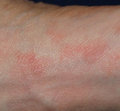Definition
Scabies is a relatively contagious infection caused by a tiny mite.
Description
Scabies is caused by a tiny, 0.3 mm long, insect called a mite. When a human comes in contact with the female mite, the mite burrows under the skin, laying eggs along the line of its burrow. These eggs hatch, and the resulting offspring rise to the surface of the skin, mate, and repeat the cycle either within the skin of the original host, or within the skin of its next victim.
The intense itching almost always caused by scabies is due to a reaction within the skin to the feces of the mite. The first time someone is infected with scabies, he or she may not notice any itching for a number of weeks (four to six weeks). With subsequent infections, the itchiness will begin within hours of picking up the first mite.
Causes & symptoms
Scabies is most common among people who live in overcrowded conditions, and whose ability to practice good hygiene is limited. Scabies can be passed between people by close skin contact. Although the mites can only live away from human skin for about three days, sharing clothing or bedclothes can pass scabies among family members or close contacts.
The itching from scabies is worse after a hot shower and at night. Burrows are seen as winding, slightly raised gray lines along the skin. The female mite may be seen at one end of the burrow, as a tiny pearl-like bump underneath the skin. Because of the intense itching, burrows may be obscured by scratch marks left by the patient. The most common locations for burrows include the sides of the fingers, between the fingers, the top of the wrists, around the elbows and armpits, around the nipples of the breasts in women, in the genitalia of men, around the waist (beltline), and on the lower part of the buttocks. Babies may have burrows on the soles of their feet, palms of their hands, and faces.
Scratching seems to serve some purpose in scabies, as the mites are apparently often inadvertently removed. Most infestations with scabies are caused by no more than 15 mites altogether.
Infestation with huge numbers of mites (on the order of thousands to millions) occurs when an individual does not scratch, or when an individual has a weakened immune system. These patients include those who live in institutions; are mentally retarded, or physically infirm; have other diseases which affect the amount of sensation they have in their skin (leprosy or syringomyelia); have leukemia or diabetes; are taking medications which lower their immune response (cancer chemotherapy, drugs given after organ transplantation); or have other diseases which lower their immune response (such as acquired immunodeficiency syndrome or AIDS). This form of scabies, with its major infestation, is referred to as crusted scabies or Norwegian scabies. Infected patients have thickened, crusty areas all over their bodies, including over the scalp. Their skin is scaly. Their fingernails may be thickened and horny.
Diagnosis
Diagnosis can be made simply by observing the characteristic burrows of the mites causing scabies. A sterilized needle can be used to explore the pearly bump at the end of a burrow, remove its contents, and place it on a slide to be examined. The mite itself may then be identified under a microscope.
Occasionally, a type of mite carried on dogs may infect humans. These mites cannot survive for very long on humans, and so the infection is very light.
Treatment
Several types of lotions (1% lindane or 5% permethrin) can be applied to the body, and left on for 12-24 hours. This is usually sufficient, although it may be reapplied after a week if mites remain. Preparations containing lindane should not be used to treat pregnant women and infants. Itching can be lessened by the use of calamine lotion and antihistamine medications.
Prognosis
The prognosis for complete recovery from scabies infestation is excellent. In patients with weak immune systems, the biggest danger is that the areas of skin involved with scabies will become secondarily infected with bacteria.
Prevention
Good hygiene is essential in the prevention of scabies. When a member of a household is diagnosed with scabies, all that person's recently-worn clothing and bedding should be washed in very hot water.
Further Reading
For Your Information
Books
- Darmstadt, Gary L., and Al Lane. "Arthropod Bites and Infestations." In Nelson Textbook of Pediatrics, edited by Richard Behrman. Philadelphia: W.B. Saunders Co., 1996.
- Maguire, James H. "Ectoparasite Infestations and Arthropod Bites and Stings." In Harrison's Principles of Internal Medicine, edited by Anthony S. Fauci, et al. New York: McGraw-Hill, 1998.
- Stoffman, Phyllis. The Family Guide to Preventing and Treating 100 Infectious Diseases. New York: John Wiley and Sons, Inc., 1995.
Periodicals
- Apgar, Barbara. "Comparison of Lindane and Permethrin for Scabies." American Family Physician, 54 (7)(November 15, 1996): 2293+.
- Forsman, Karen E. "Pediculosis and Scabies: What to Look For In Patients Who Are Crawling With Clues." Postgraduate Medicine, 98 (6)(December 1995): 89+.
- Moore, Adrienne V. "Stopping the Spread of Scabies." American Journal of Nursing, 97 (10)(November 15, 1996): 2293+.
- Pariser, Robert J. "Scabies: The Myth and the Reality." Consultant, 36 (3)(March 1996): 527+.
Gale Encyclopedia of Medicine. Gale Research, 1999.




